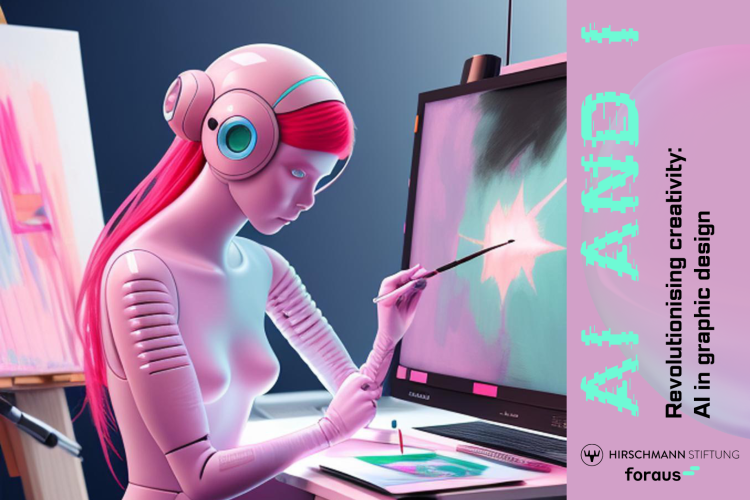Introduction: Designing in the Age of Intelligent Machines
Artificial Intelligence is not only a tool for efficiency; it is a co-author of aesthetics. As algorithms generate visuals, layouts, and interactive experiences, designers are confronted with new possibilities and challenges. The rise of AI reshapes visual language, challenges traditional notions of beauty, and transforms how we conceptualize and execute design thinking.
Designers no longer merely choose colors, fonts, or shapes — they navigate algorithmic aesthetics, co-creating with machines that synthesize patterns and styles from vast datasets. This collaboration fundamentally alters the cognitive framework of design, blending human judgment with machine intelligence.
This essay explores how AI redefines visual language, expands design thinking, and introduces a new philosophy of creativity where humans and algorithms co-author aesthetics.
1. AI as a New Visual Language
1.1 Beyond Human Intuition
Traditional design is guided by human intuition, cultural norms, and established principles of composition. AI introduces a non-human logic. Algorithms can detect patterns invisible to humans and generate combinations that challenge conventional aesthetics.
For instance, generative adversarial networks (GANs) can create textures, forms, and color schemes that defy existing visual hierarchies, yet maintain a sense of coherence. Designers learn to interpret these outputs, discovering visual grammar emerging from data-driven patterns.
1.2 Emergent Styles and Hybrid Aesthetics
AI can merge styles across epochs, cultures, or disciplines. Consider an AI generating a poster that combines Bauhaus minimalism with African tribal motifs or blending modern digital textures with Renaissance chiaroscuro.
This capability expands the palette of human creativity, enabling hybrid aesthetics that were previously unattainable.
2. Algorithmic Design Thinking
2.1 From Linear to Non-Linear Process
Traditional design thinking often follows a linear path: research → ideation → prototyping → testing. AI encourages non-linear exploration:
- Prompt an AI → Generate multiple outputs → Evaluate emergent forms → Refine prompt → Iterate
- AI surfaces novel solutions that may defy the designer’s initial assumptions, prompting reflection and reinterpretation.
This iterative dialogue transforms design thinking into a co-evolutionary process, where problem definition and solution exploration occur simultaneously.
2.2 Data-Driven Decision Making
AI empowers designers to leverage large datasets for aesthetic decisions. For example, analyzing user engagement across millions of web pages can guide font choice, layout hierarchy, or color palette.
Design thinking now incorporates quantitative insight into qualitative judgment, creating a fusion of intuition and analytics.
3. New Principles of AI-Enhanced Aesthetics
3.1 Complexity and Simplicity
AI can balance complexity and simplicity with remarkable precision. By modeling visual attention and cognitive load, algorithms can suggest layouts that maximize clarity while maintaining richness.
Designers must interpret these suggestions, choosing when to follow the algorithm and when to introduce human imperfection for emotional resonance.
3.2 Novelty as a Metric
Human designers often rely on familiar patterns. AI introduces novelty by combining distant visual concepts.
Designers now measure aesthetic value not only by traditional principles (contrast, balance, rhythm) but also by how surprising or innovative the output is, creating a quantifiable dimension to creativity.
3.3 Emergence of Generative Rules
Generative AI models learn implicit rules from datasets. Designers engage with these rules indirectly, interpreting emergent constraints rather than explicitly coding every principle.
This requires a shift in mindset: from control to curation, from prescriptive design to interpreting emergent visual logic.
4. Case Studies: AI in Contemporary Design
4.1 Graphic Design
Platforms like Midjourney or Adobe Firefly enable designers to generate visual concepts rapidly. Posters, book covers, and advertisements can now reflect algorithmically synthesized styles that blend global influences.
Designers act as interpreters, selecting outputs that align with brand identity while exploring visual directions that were previously unconsidered.
4.2 Architecture and Spatial Design
Generative design tools are revolutionizing architecture. AI can propose structurally optimized forms, simulate lighting and airflow, and integrate environmental data.
Architects now explore visual and functional aesthetics simultaneously, creating forms that are both beautiful and sustainable.
4.3 UI/UX and Interaction Design
In interface design, AI can analyze user behavior to suggest adaptive layouts and dynamic color schemes. Interaction patterns emerge based on data rather than solely on designer intuition.
The result: interfaces that are aesthetically pleasing, functional, and responsive to real-world usage.
5. The Cognitive Shift: Thinking with AI
5.1 From Manual to Conceptual
Designers spend less time on manual execution and more on conceptual exploration. Prompt engineering becomes a form of creative literacy — the ability to translate abstract ideas into instructions an algorithm can interpret.
5.2 Feedback Loops and Reflexive Design
AI introduces rapid feedback loops. Designers generate outputs, evaluate, and iterate in real time.
This reflexive design approach accelerates experimentation and enables risk-taking without significant cost, fostering innovation in form, color, and interaction.
5.3 Collaboration as a Cognitive Model
Humans and AI together form a distributed cognitive system. The designer contributes intuition, empathy, and cultural context; the AI contributes scale, pattern recognition, and speed.
Design thinking becomes co-creative intelligence, blending human foresight with algorithmic exploration.

6. Ethical and Aesthetic Considerations
6.1 Originality and Authorship
As AI generates content, questions arise about authorship. Designers must navigate intellectual property challenges and determine how to attribute human and machine contributions.
Originality is now a combination of human judgment and algorithmic synthesis.
6.2 Bias in Aesthetic Output
AI reflects the biases of its training data. Designers must critically evaluate outputs to prevent cultural or visual homogenization.
Ethical responsibility is integral to aesthetic curation, ensuring diversity and representation in visual design.
6.3 Human Emotion and Machine Logic
AI excels in generating patterns but lacks emotion. Designers must infuse outputs with human affect, ensuring that visuals resonate culturally, socially, and psychologically.
7. Implications for Design Education
7.1 Teaching Algorithmic Literacy
Future designers need fluency in AI tools, generative models, and prompt engineering. Education must evolve to balance traditional aesthetics with algorithmic thinking.
7.2 Encouraging Critical Evaluation
Students must learn to critique AI outputs, understanding both possibilities and limitations. Evaluation skills become as important as execution skills.
7.3 Fostering Hybrid Creativity
Educational programs should emphasize co-creative intelligence — nurturing designers who can collaborate with algorithms while maintaining human vision.
Conclusion: The Symbiosis of Human and Machine Aesthetics
AI transforms the language of design, introducing novel forms, hybrid styles, and new principles of visual thinking. Designers no longer operate in isolation; they collaborate with algorithms to explore possibilities beyond human intuition.
In this era, aesthetics is not merely human or machine — it is co-authored, emerging from the interplay of intuition, pattern recognition, and data-driven insight. Design thinking evolves into a hybrid cognitive process, where imagination is amplified by computation and beauty is redefined by the dialogue between human and machine.
The future of design is not about humans versus AI — it is about humans thinking with AI, exploring uncharted creative territories, and redefining the boundaries of visual language for generations to come.











































